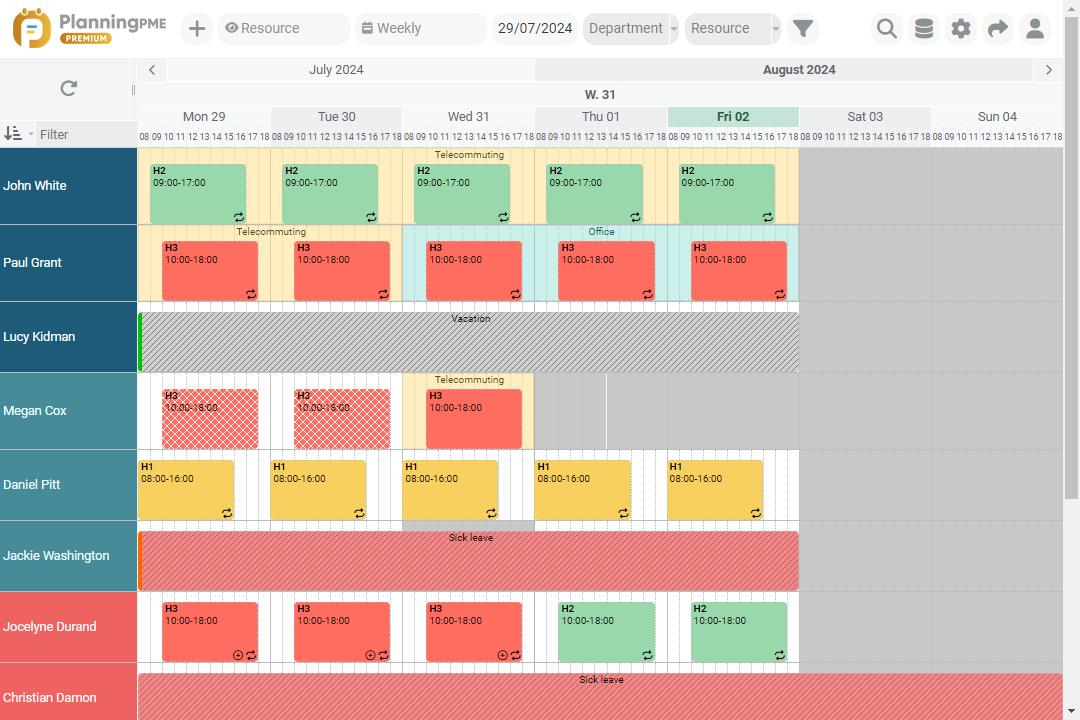Leave management system
Efficiently track, approve, and manage employee leave requests with a powerful resource scheduling software
Get started Request a demo
Managing the employee leave schedule is crucial for ensuring optimal organisation within the company. The company's leave schedule includes various types of leave, such as paid leave, unpaid leave, sick leave, maternity leave, and paternity leave. During the summer, planning summer and annual leave must be done carefully to avoid disruptions. Every year, it is essential to anticipate leave dates, leave requests, and effectively manage leave-taking to maintain a balance between employee needs and the company's operational requirements.
Key features for leave scheduling
Holidays and days off
Human and/or material resources
History and follow up
Organise leaves and absences

Effective management of leave reasons, leave periods, and leave departures helps maintain high productivity while considering individual employee needs. By ensuring that holidays are distributed fairly and that working hours are respected, HR ensures that each employee can enjoy their annual leave.
Manage absences and holidays of your employees easily . You can even show within the planning board the number of employees off at any time so that your planner can plan in advance the activity.
Access your leave schedule anytime, anywhere
Leave management is always complicated in a company. With PlanningPME manage time off and holidays of your employees easily. Visualise at a glance how many employees are off and why. PlanningPME allows you to have different graphical views on your schedule.
You can view the daily schedule, weekly schedule or monthly for example. With an overview of your staff presence, you can spread the workload easily and become more efficient on a daily basis.
With the history option, you can access the details of each of your coworker absences as well as their remaining days off. Real time update enables you to improve the administrative management of your employees.
They trust us
From the plethora of software available for tracking absences and holidays, PlanningPME immediately seemed to us to be the best choice available. Easy to install and intuitive to use, our different users have adopted it very quickly. As a specialist in the manufacture of printing machines and the converting of packaging materials, DCM has to manage increasingly complex human resources on a daily basis: holidays, RTT, sickness and also business travel or the organisation of technical teams in the factory or abroad. I will add that PlanningPME has been designed with a real understanding of the needs of small- and medium-sized business, it is scalable, and adapts to the needs of each user. Finally, its modest cost and the quality and dynamism of the Target Skill team should convince any remaining sceptics.
SARL MBT

Fédération des Chasseurs 74

FAQ
To create a leave schedule, start by collecting leave requests from employees while taking into account critical periods for the business. Then, organise the leaves in a way that ensures sufficient coverage of operations, avoiding problematic overlaps. Finally, communicate the schedule to all employees concerned and make sure to update it in case of changes or cancellations.
Here's how to draw up a paid holiday plan in 5 steps:
- Collect holiday requests : Ask each employee to submit their preferred dates of leave, within the deadlines set by the company.
- Analyse operational needs : Identify the critical periods when the presence of certain employees is essential, in order to guarantee business continuity.
- Setting priorities : If multiple employees request the same dates, apply priority criteria, such as seniority, family needs, or a rotation system.
- Create the schedule : Assign leave dates taking into account demands, priorities and operational needs, while ensuring that there are always enough staff to cover operations.
- Communicate and validate : Spread the schedule to employees concerned for approval, and adjust it if necessary based on feedback or unforeseen events.
To keep track of leaves and absences in your company, use leave management software that makes it easy to centralise requests and approve them. Maintain an up-to-date shared calendar so that everyone has an overview of planned absences. Finally, regularly monitor leave balances and analyse absence trends to anticipate operational needs.
30-day free trial to boost your schedule management
Request a demo Free trial




